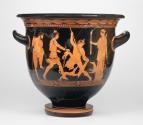Advanced Search
Mixing bowl (bell krater)
Greek
Classical Period
about 440 B.C.
Place of Manufacture: Greece, Attica, Athens
Medium/Technique
Ceramic, Red Figure
Dimensions
Height: 37.8 cm (14 7/8 in.)
Credit Line
Henry Lillie Pierce Fund
Accession Number00.346
CollectionsAncient Greece and Rome
ClassificationsVessels
Catalogue Raisonné
Caskey-Beazley, Attic Vase Paintings (MFA), no. 110.
DescriptionSide A: Each character has an accompanying inscription (above the head). Aktaion (AKTAION) attacked by dogs; Artemis (ARTEMIS), Lyssa (LYSA), and Zeus (DIOS ) present. Above the inscription 'Aktaion', near the upper border of the picture, is the word 'Euaion' (EVAION).
Side B: Youth standing between two women. Repaired with some restorations.
Under the foot, in the center, the graffito he (HE).
[Label text]:
The myth of Actaeon is illustrated on this bell krater. While hunting with his dogs on Mount Cithaeron, Actaeon happened upon the beautiful goddess Artemis bathing in a spring. So angry that he had seen her without her clothes, Artemis transformed him into a stag. Actaeon's hunting dogs then turned upon him and devoured their master, not recognizing him. In the depiction of the myth here, Artemis stands to the right while Aktaion is attacked by three of his dogs. He is in the process of changing into a deer; two antlers and two pointed ears grow from the top of his head. To the left of Aktaion stands Lyssa, a personification of Fury and Madness. She is dressed in the boots and hide jacket of a hunter, perhaps to indicate that she is acting on behalf of Artemis. Lyssa was also a personification of rabies. Lyssa has infected Aktaion's dogs with madness in order to avenge the dishonor done to Artemis. Zeus stands to the far left, resting his foot on a rock and observing the scene.
Side B: Youth standing between two women. Repaired with some restorations.
Under the foot, in the center, the graffito he (HE).
[Label text]:
The myth of Actaeon is illustrated on this bell krater. While hunting with his dogs on Mount Cithaeron, Actaeon happened upon the beautiful goddess Artemis bathing in a spring. So angry that he had seen her without her clothes, Artemis transformed him into a stag. Actaeon's hunting dogs then turned upon him and devoured their master, not recognizing him. In the depiction of the myth here, Artemis stands to the right while Aktaion is attacked by three of his dogs. He is in the process of changing into a deer; two antlers and two pointed ears grow from the top of his head. To the left of Aktaion stands Lyssa, a personification of Fury and Madness. She is dressed in the boots and hide jacket of a hunter, perhaps to indicate that she is acting on behalf of Artemis. Lyssa was also a personification of rabies. Lyssa has infected Aktaion's dogs with madness in order to avenge the dishonor done to Artemis. Zeus stands to the far left, resting his foot on a rock and observing the scene.
InscriptionsSide A (From L to R)
ΔΙΟΣ
ΛVΣΑ
ΕVΑΙΟΝ
ΑΚΤΑΙΟΝ
ΑΡΤΕΜΙΣ
Graffito under foot: ΗΕ
ΔΙΟΣ
ΛVΣΑ
ΕVΑΙΟΝ
ΑΚΤΑΙΟΝ
ΑΡΤΕΜΙΣ
Graffito under foot: ΗΕ
ProvenanceAlessandro Castellani (b. 1823 - d. 1883), Rome; March 17-April 10, 1884, posthumous Castellani sale, Palazzo Castellani, Rome, lot 83. Michal Tyszkiewicz (b. 1828 - d. 1897), Rome [see note 1]. By 1900, Edward Perry Warren, Boston; 1900, sold by Warren to the MFA [see note 2]. (Accession Date: February 1, 1900)
NOTES:
[1] According to Warren's notes and Wilhelm Klein, Die griechischen Vasen mit Lieblingsinschriften (1898), p. 132.
[2] According to L. D. Caskey and J. D. Beazley, Attic Vase Paintings in the Museum of Fine Arts, Boston, II, no. 110, this comes from Vico Equense (NE of Sorrento).
NOTES:
[1] According to Warren's notes and Wilhelm Klein, Die griechischen Vasen mit Lieblingsinschriften (1898), p. 132.
[2] According to L. D. Caskey and J. D. Beazley, Attic Vase Paintings in the Museum of Fine Arts, Boston, II, no. 110, this comes from Vico Equense (NE of Sorrento).






